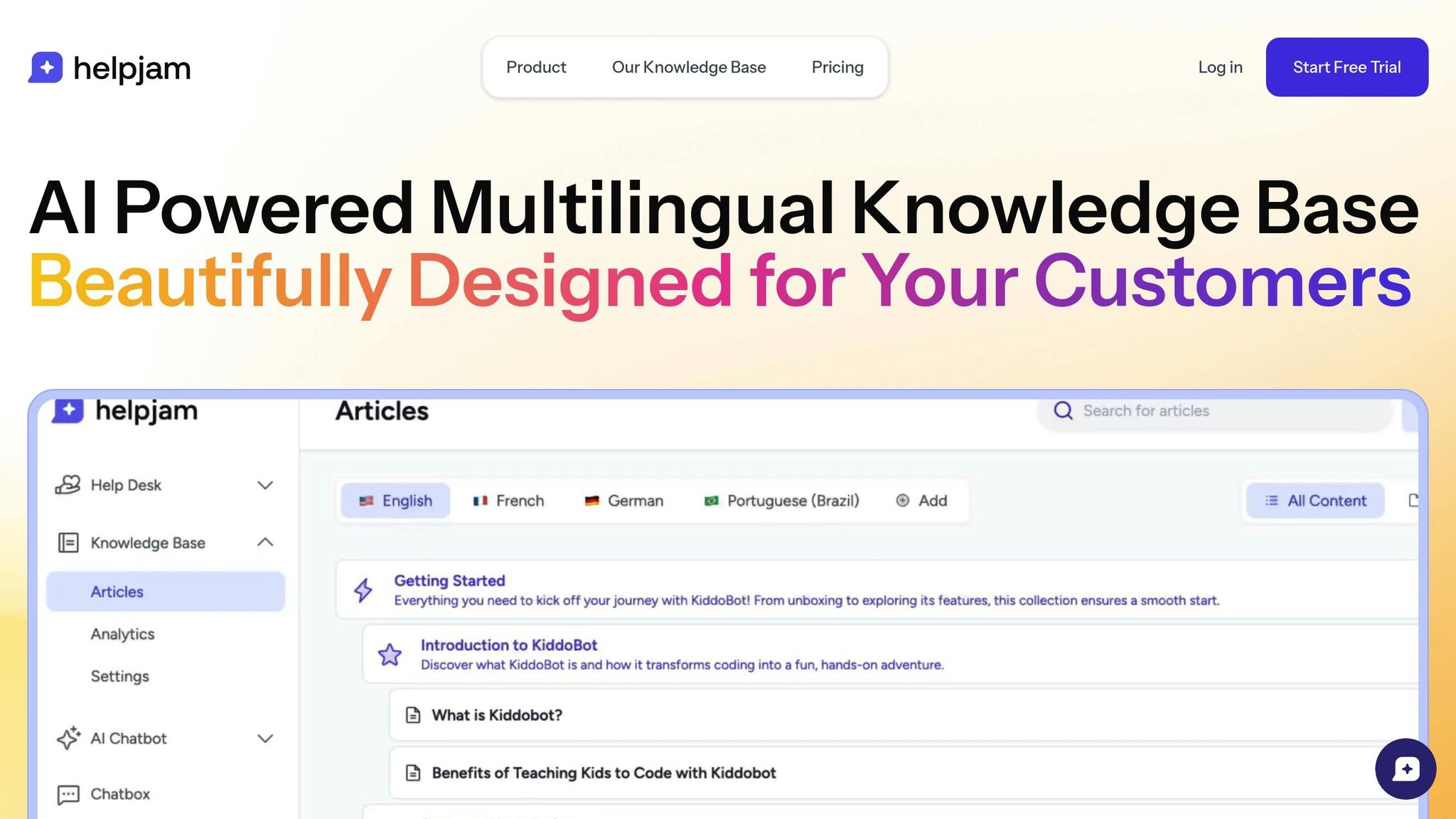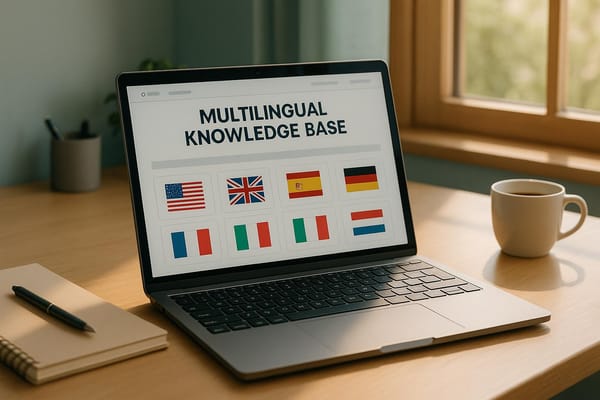How to Create a Multilingual Knowledge Base
Creating a multilingual knowledge base enhances customer trust and support efficiency, driving global growth through tailored content.

Want to support customers worldwide? A multilingual knowledge base is the answer. It helps users find answers in their language, reduces support costs, and makes global expansion smoother. Here's what you need to know:
- Why it matters: Improves customer trust, lowers support tickets, and boosts global growth.
- How to start: Choose key languages, prepare clear content, and use AI tools for fast, accurate translations.
- Keep it updated: Sync changes across languages and tailor content for local needs.
- Tools to use: Platforms like HelpJam simplify translations, manage updates, and improve multilingual search.
Bottom line: A multilingual knowledge base makes self-service support accessible for everyone, no matter where they are. Ready to start? Let’s dive in!
1. Why Multilingual Support Makes Business Sense
Communicating in Customers' Native Language Builds Trust
When you provide support in a customer's native language, it shows respect for their preferences and helps form a stronger connection. Customers are more likely to feel understood and valued, which increases their engagement with your product. This approach can positively influence buying decisions and encourage long-term loyalty.
Self-Service Lowers Support Requests
A multilingual knowledge base that's easy to navigate can significantly reduce the number of basic support inquiries, making your operations more efficient. Here's how it helps:
- Quicker Issue Resolution: Providing content in native languages helps customers solve problems faster.
- Reduced Costs: With fewer live support requests, you can save on operational expenses.
- 24/7 Accessibility: Multilingual resources ensure assistance is available anytime, across different time zones.
This efficiency not only improves customer satisfaction but also supports business expansion.
Expanding Into New Markets
Offering support in local languages makes it easier to enter new markets, establish credibility right away, and engage customers without needing to dramatically increase your support team.
Companies that prioritize multilingual support often see happier customers, fewer support tickets, and greater product adoption. But it's not just about translating content - it's about creating meaningful connections with customers worldwide while keeping operations smooth. Investing in multilingual support early can position your business for steady growth on a global scale.
2. How to Build Your Multilingual Knowledge Base
Choose Your Languages
Start by analyzing your data to identify which languages will have the most impact. Focus on:
- Website analytics showing where your visitors are coming from and their language preferences
- The languages used in support tickets
- Customer feedback asking for specific language support
- Plans to expand into new markets
It's better to focus on a few key languages and do them well rather than spreading yourself too thin.
Prepare Your Base Content
Make sure your original content is easy to translate and maintain. Here's how:
- Break topics into clear, consistent sections
- Avoid region-specific references or idioms that might not translate well
- Use clear headers and subheaders to organize information
- Add visuals that are universally relevant across cultures
A well-organized base makes translation smoother and keeps everything easier to manage.
Use AI Translation Tools
AI tools like HelpJam can simplify the translation process by:
- Translating entire articles quickly
- Keeping the original formatting intact
- Preserving technical terms and brand names
- Learning from your edits to improve future translations
- Supporting up to five languages in the Growth Plan
Once you've translated your content, make sure you have a system in place to keep it updated.
Set Up Content Update Rules
-
Update Base Content First
- Edit your primary language articles first
- Keep a record of all changes in one central location
-
Trigger Translation Updates
- Use HelpJam’s one-click retraining to update translations
- Review major changes to ensure accuracy
- Conduct regular audits to keep everything consistent
These steps will help you maintain a strong foundation for regional adjustments.
Adjust Content Per Region
Tailor your content to meet the needs of each market. This might include:
- Adjusting examples to match local business practices
- Updating screenshots to show localized interfaces
- Modifying payment instructions for regional methods
- Aligning support hours with local time zones
- Including details about local regulations or compliance
You can manage these regional tweaks easily through a single dashboard, keeping everything organized and efficient.
3. Common Problems and Fixes
Managing a multilingual knowledge base comes with its own set of challenges, but there are practical ways to address them.
Cut Down on Translation Time and Costs
Manual translations can be slow and expensive. To make the process more efficient:
- Use AI tools to handle the initial translation step
- Focus human review efforts on the most critical articles
- Build a translation memory for commonly used phrases
- Develop templates for frequently updated content like product announcements
Once translated, ensure the articles stay consistent across all languages.
Keep Content Aligned Across Languages
When content isn't synchronized, it can confuse customers and lead to more support requests. To prevent this, set up a system that:
- Automatically updates all language versions when changes are made
- Tracks edits with version control tools
- Conducts regular audits to ensure everything matches
HelpJam offers a centralized dashboard to manage all language versions efficiently.
Improve Search Across All Languages
A strong multilingual search function makes it easier for users to find what they need, reducing frustration and enhancing your knowledge base's usefulness. Here’s how to improve search performance:
- Use AI and natural language processing to understand user intent and provide smart search suggestions
- Create language-specific synonyms for popular search terms
- Build a keyword database that works across multiple languages for better accuracy
HelpJam’s AI-powered search engine processes queries in real time, delivering accurate results no matter the language. Organizing your content with clear titles, headers, meta descriptions, and well-structured tags ensures better indexing and search results.
4. HelpJam Tools for Multilingual Content

HelpJam simplifies managing multilingual content with tools designed to tackle common translation challenges in global customer support.
AI-Powered Translations
HelpJam's AI translation tool translates articles while keeping the original layout intact. It ensures your multilingual content is consistent and ready to publish. Plus, it gets smarter over time by learning from your edits.
Unlimited Language Options
Start with a few languages and scale up as needed. The Growth Plan includes support for 5 languages, while the Business Plan lets you add as many as you want - without extra fees. Manage all language versions easily from a single domain.
Multilingual AI Chat Support
Use your translated content to power AI chat support in different languages. When the AI can't handle a query, it seamlessly hands it off to a human agent, ensuring smooth, uninterrupted customer service.
Centralized Dashboard
Handle all your language versions from one dashboard. It syncs updates across languages and includes analytics to help you spot areas that need improvement. This setup keeps your workflow efficient and your content consistent.
HelpJam makes managing multilingual content straightforward, helping businesses provide seamless global customer support.
Next Steps: Launch Your Multilingual Knowledge Base
Get your multilingual knowledge base live with HelpJam's AI-powered tools.
Now that you've completed the planning and content preparation stages, it's time to bring it all together for a smooth launch. Here's what you need to do before diving into translations:
-
Fine-Tune Your Content
- Go through existing articles to ensure clarity and consistency.
- Standardize formatting for a cohesive look.
- Remove any outdated or irrelevant information.
-
Set Up Language Features
- Enable auto-detection for user languages.
- Choose default fallback languages.
- Test the language-switching functionality to ensure it works seamlessly.
-
Organize Your Workflow
- Define triggers for content updates.
- Establish a clear review process for translations.
- Set up automated schedules to sync content across languages.
Once your knowledge base is live, use HelpJam's analytics dashboard to track performance. Keep an eye on these key stats:
- Views per language
- Search success rates
- Self-service resolution rates
- Trends in language preferences
For businesses just starting with multilingual support, the Growth Plan covers 5 languages and includes all core AI translation tools. Need more? The Business Plan offers unlimited language support, perfect for growing teams.
Kick off your multilingual knowledge base today with HelpJam's Growth Plan. Start translating your key articles in just a few hours and deliver better support to your global audience.





